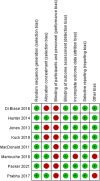Catheter Ablation Versus Medical Therapy for Atrial Fibrillation in Patients with Heart failure: A Meta-Analysis of Randomized Controlled Trials
- PMID: 35949135
- PMCID: PMC9524201
- DOI: 10.5152/AnatolJCardiol.2022.1826
Catheter Ablation Versus Medical Therapy for Atrial Fibrillation in Patients with Heart failure: A Meta-Analysis of Randomized Controlled Trials
Abstract
Background: The optimal treatments for atrial fibrillation in heart failure patients are controversial. The present study compared the efficacy of catheter ablation and medical therapy in patients with atrial fibrillation and heart failure.
Methods: Pubmed, Embase, Cochrane Library, and Web of Science were searched until January 15, 2022. Randomized controlled trials comparing catheter ablation for atrial fibrillation with medical therapy in patients with atrial fibrillation and heart failure were enrolled. Primary outcome was all-cause mortality. Secondary outcomes included the heart failure hospitalization and the change in left ventricular ejection fraction, 6-minute walk test distance, peak oxygen consumption, and Minnesota Living with Heart Failure questionnaire score.
Results: Totally 8 randomized controlled trials involving 1693 patients were included. Compared with medical therapy, catheter ablation significantly reduced all-cause mortality (risk ratios=0.60, 95% Cl: 0.45 to 0.80, P < .001) and hospitalization due to heart failure (risk ratios=0.58, 95% Cl: 0.46 to 0.73, P < .001), improved left ventricular ejection fraction (mean difference=5.25%, 95% CI: 2.78% to 7.71%, P < .001), improved the performance of 6-minute walk test (mean difference=28.83 m, 95% CI: 8.61 to 49.05 m, P=.005), increased peak oxygen consumption (mean difference=3.11 mL/kg/min, 95% CI: 1.04 to 5.18 mL/kg/min, P=.003), and reduced Minnesota Living with Heart Failure score (mean difference=-8.45, 95% CI: -16.28 to -0.62, P=.03).
Conclusion: In heart failure patients with atrial fibrillation, catheter ablation provides more benefits over medical therapy in the important clinical outcomes, exercise capacity, and quality of life.
Figures





Similar articles
-
Catheter Ablation of Atrial Fibrillation in Patients With Heart Failure: A Meta-analysis of Randomized Controlled Trials.Ann Intern Med. 2019 Jan 1;170(1):41-50. doi: 10.7326/M18-0992. Epub 2018 Dec 25. Ann Intern Med. 2019. PMID: 30583296
-
Efficacy of catheter ablation for atrial fibrillation in heart failure: a meta-analysis of randomized controlled trials.ESC Heart Fail. 2024 Oct;11(5):2684-2693. doi: 10.1002/ehf2.14814. Epub 2024 Apr 25. ESC Heart Fail. 2024. PMID: 38661235 Free PMC article.
-
Catheter Ablation Versus Medical Therapy for Atrial Fibrillation in Patients With Heart Failure: A Meta-Analysis of Randomised Controlled Trials.Heart Lung Circ. 2019 May;28(5):707-718. doi: 10.1016/j.hlc.2018.10.022. Epub 2018 Nov 17. Heart Lung Circ. 2019. PMID: 30509786 Review.
-
Catheter Ablation Compared with Medical Therapy for Atrial Fibrillation with Heart Failure: A Systematic Review and Meta-analysis of Randomized Controlled Trials.Int J Med Sci. 2021 Jan 21;18(6):1325-1331. doi: 10.7150/ijms.52257. eCollection 2021. Int J Med Sci. 2021. PMID: 33628087 Free PMC article.
-
Catheter ablation for treatment of patients with atrial fibrillation and heart failure: a meta-analysis of randomized controlled trials.BMC Cardiovasc Disord. 2018 Aug 13;18(1):165. doi: 10.1186/s12872-018-0904-3. BMC Cardiovasc Disord. 2018. PMID: 30103676 Free PMC article. Review.
Cited by
-
Assessment of Redundant Meta-Analyses on Catheter Ablation of Atrial Fibrillation in Patients with Heart Failure.Rev Cardiovasc Med. 2024 Nov 21;25(11):418. doi: 10.31083/j.rcm2511418. eCollection 2024 Nov. Rev Cardiovasc Med. 2024. PMID: 39618855 Free PMC article.
-
The risk of malnutrition as a predictor of arrhythmia recurrence after catheter ablation in patients with paroxysmal non-valvular atrial Fibrillation and heart failure with preserved ejection fraction.PLoS One. 2025 Jan 31;20(1):e0317721. doi: 10.1371/journal.pone.0317721. eCollection 2025. PLoS One. 2025. PMID: 39888955 Free PMC article.
References
-
- Hindricks G, Potpara T, Dagres N.et al. ESC Guidelines for the diagnosis and management of atrial fibrillation developed in collaboration with the European Association for Cardio-Thoracic Surgery (EACTS): the Task Force for the diagnosis and management of atrial fibrillation of the European Society of Cardiology (ESC) Developed with the special contribution of the European Heart Rhythm Association (EHRA) of the ESC. Eur Heart J. 2020;425:373 498. - PubMed
Publication types
MeSH terms
LinkOut - more resources
Full Text Sources
Medical

